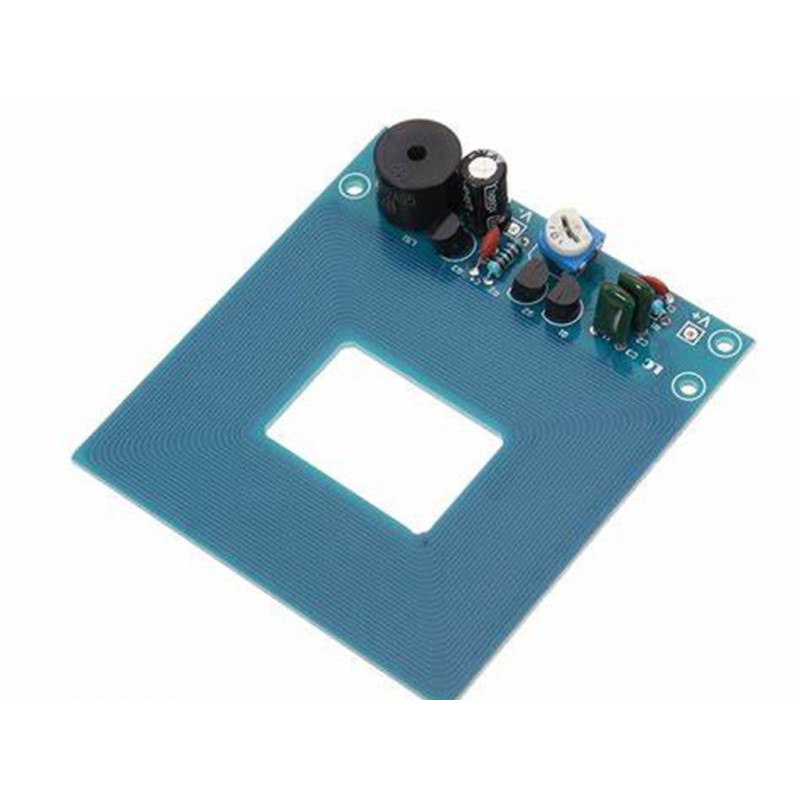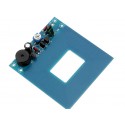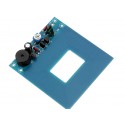Metal Detector Modulenon Contact Metal Induction Sensor
Rs. 109.00 Rs. 125.00
- Product Code: SEN-METAL
- Availability: In Stock
- Price in reward points: 2
- For Bulk Order
 9962060070
9962060070
| SPECIFICATIONS | |
| Operating Voltage (VDC) | 5 |
| Detecting Range | 1 CM |
OVERVIEW:
-Operating voltage: 5V DC.
-Detector distance: 1CM.
-Adjust the potentiometer, let the modules work normally.
-Small and easy to use module.
-It comes with a Buzzer for metal detection indication.
PACKAGE INCLUDES:
1 PCS x Metal Detector Modulenon Contact Metal Induction Sensor
//SOURCE CODE TAKEN FROM BELOW LINK
//https://github.com/evankale/ArduinoMetalDetector/blob/master/ArduinoMetalDetector.ino
/*
* Copyright (c) 2016 Evan Kale
* Media: @EvanKale91
* Email: EvanKale91@gmail.com
* Website: www.ISeeDeadPixel.com
* www.evankale.blogspot.ca
* www.youtube.com/EvanKale91
*
* This file is part of ArduinoMetalDetector.
*
* ArduinoMetalDetector is free software: you can redistribute it and/or modify
* it under the terms of the GNU General Public License as published by
* the Free Software Foundation, either version 3 of the License, or
* (at your option) any later version.
*
* This program is distributed in the hope that it will be useful,
* but WITHOUT ANY WARRANTY; without even the implied warranty of
* MERCHANTABILITY or FITNESS FOR A PARTICULAR PURPOSE. See the
* GNU General Public License for more details.
*
* You should have received a copy of the GNU General Public License
* along with this program. If not, see <http://www.gnu.org/licenses/>.
*/
// Number of cycles from external counter needed to generate a signal event
#define CYCLES_PER_SIGNAL 5000
// Base tone frequency (speaker)
#define BASE_TONE_FREQUENCY 280
// Frequency delta threshold for fancy spinner to trigger
#define SPINNER_THRESHOLD 700
// Pin definitions
#define SENSITIVITY_POT_APIN 1
#define SPEAKER_PIN 2
#define SPINNER_PIN 9
#define TRIGGER_BTN_PIN 11
#define RESET_BTN_PIN 12
unsigned long lastSignalTime = 0;
unsigned long signalTimeDelta = 0;
boolean firstSignal = true;
unsigned long storedTimeDelta = 0;
// This signal is called whenever OCR1A reaches 0
// (Note: OCR1A is decremented on every external clock cycle)
SIGNAL(TIMER1_COMPA_vect)
{
unsigned long currentTime = micros();
signalTimeDelta = currentTime - lastSignalTime;
lastSignalTime = currentTime;
if (firstSignal)
{
firstSignal = false;
}
else if (storedTimeDelta == 0)
{
storedTimeDelta = signalTimeDelta;
}
// Reset OCR1A
OCR1A += CYCLES_PER_SIGNAL;
}
void setup()
{
// Set WGM(Waveform Generation Mode) to 0 (Normal)
TCCR1A = 0b00000000;
// Set CSS(Clock Speed Selection) to 0b111 (External clock source on T0 pin
// (ie, pin 5 on UNO). Clock on rising edge.)
TCCR1B = 0b00000111;
// Enable timer compare interrupt A (ie, SIGNAL(TIMER1_COMPA_VECT))
TIMSK1 |= (1 << OCIE1A);
// Set OCR1A (timer A counter) to 1 to trigger interrupt on next cycle
OCR1A = 1;
pinMode(SPEAKER_PIN, OUTPUT);
pinMode(SPINNER_PIN, OUTPUT);
pinMode(TRIGGER_BTN_PIN, INPUT_PULLUP);
pinMode(RESET_BTN_PIN, INPUT_PULLUP);
}
void loop()
{
if (digitalRead(TRIGGER_BTN_PIN) == LOW)
{
float sensitivity = mapFloat(analogRead(SENSITIVITY_POT_APIN), 0, 1023, 0.5, 10.0);
int storedTimeDeltaDifference = (storedTimeDelta - signalTimeDelta) * sensitivity;
tone(SPEAKER_PIN, BASE_TONE_FREQUENCY + storedTimeDeltaDifference);
if (storedTimeDeltaDifference > SPINNER_THRESHOLD)
{
digitalWrite(SPINNER_PIN, HIGH);
}
else
{
digitalWrite(SPINNER_PIN, LOW);
}
}
else
{
noTone(SPEAKER_PIN);
digitalWrite(SPINNER_PIN, LOW);
}
if (digitalRead(RESET_BTN_PIN) == LOW)
{
storedTimeDelta = 0;
}
}
float mapFloat(int input, int inMin, int inMax, float outMin, float outMax)
{
float scale = (float)(input - inMin) / (inMax - inMin);
return ((outMax - outMin) * scale) + outMin;
}
© 2021 GitHub, Inc.
15 days




